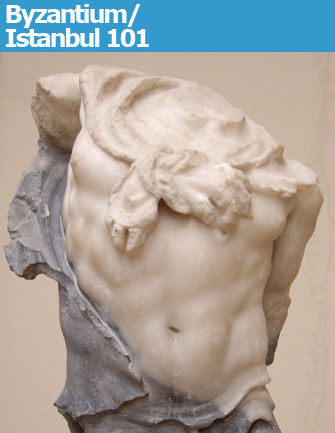 |
|
“Bust of Triton” (2nd century). © Istanbul Archeology Museums / Bahadir Taskin |
Istanbul is one of the world’s most fascinating cities for a number of reasons. As the title of the current exhibition at the Grand Palais in Paris – “From Byzantium to Istanbul: One Port …
 |
|
“Bust of Triton” (2nd century). © Istanbul Archeology Museums / Bahadir Taskin |
Istanbul is one of the world’s most fascinating cities for a number of reasons. As the title of the current exhibition at the Grand Palais in Paris – “From Byzantium to Istanbul: One Port for Two Continents” – indicates, the city straddles both Europe and Asia, but beyond that, it has evolved from a prehistoric settlement to an ancient port to the Greek city of Byzance, an outpost of the Roman Empire, Christian Constantinople, Ottoman Istanbul and, finally, modern Istanbul. It is these manifold layers of history and cultures, along with its spectacular setting on both sides of the Bosporus, that make it such a beguiling place.
The Grand Palais’s exhibition is a sort of “Byzantium/Istanbul 101,” offering a broad overview of the lavish art and architecture of both the Christian and Muslim periods, although the former seems to be covered in more depth, with more objects and artifacts. The show ends with a marvelous room-sized slide show of historical and recent photos of the city, followed by an interesting presentation in videos and artifacts of the archaeological dig that is uncovering the ancient Port of Theodosius, discovered at Yenikapi in central Istanbul in 2004 during excavations for a subway tunnel.
Strangely, many of the paintings in the Istanbul section of the show were painted by Westerners, offering an outsider’s vision of the city while almost entirely omitting (in a spirit of political correctness?) the phenomenon of the harem, so fascinating to Westerners, as the historian friend who accompanied me to the show, author of a book* on the medieval history of Christianity and Islam around the Mediterranean, pointed out. He also noted that some displays – especially a series of steles from Greek, Jewish and Armenian graves in Istanbul – might surprise some of his Turkish friends, who are not always taught the full story of their country’s rich history.
While it would be impossible to do justice to a city with such a complex history in one exhibition, this show sometimes has a rather cursory feel to it, especially in the second part on Ottoman Istanbul, but it is more focused than the overambitious exhibition “Byzantium 330-1453” presented at London’s Royal Academy earlier this year, which tried to cover the art of the entire Byzantine Empire over a thousand-year period. The information (in French only) given on the some 500 objects displayed at the Grand Palais is also rather sketchy, so it might be a good idea to rent an audio guide for supplementary explanations.
Like the London show, however, this one contains many treasures that make it well worth seeing. To mention just a few: sophisticated, finely worked gold jewelry dating from the third century B.C.E., a stunningly modeled marble torso of Triton (pictured above); relief carvings from a fifth-century tomb discovered in 1988, including a wonderful depiction of Abraham holding a knife to Isaac’s neck; a leaf from a carved ivory diptych (506) showing the Roman consul Areobindus presiding over games in Constantinople’s hippodrome, full of marvelous leaping animals and men locked in combat; a piece of one of the bronze serpent heads (479 B.C.E.) that once adorned the top of the famous column in the Hippodrome; a Venetian spy’s detailed drawing of the Rumeli Hisari Fortress in 1453, the very year that Mehmet II the Conqueror sacked the city; Mehmet II’s sketchbook, with his doodles and character studies of human heads; and even a piece of the gargantuan iron chain that was stretched across the Golden Horn to keep out invaders but couldn’t stymie Mehmet II, who had his ships carried around by land to the other side of it.
Today, Istanbul is still a city torn between East and West. Turkey’s candidature for accession to the European Union is controversial both in the EU and within the country. This exhibition, part of the “season of Turkey in France” (most countries get a whole year!) seems to be straining for polite neutrality. In any case, those who already know Istanbul will appreciate being plunged into the history and atmosphere of this booming city, which now has a population of 14 million, while those who don’t yet know it will certainly be inspired to learn more and pay a visit themselves.
Galeries Nationales du Grand Palais: 3, avenue du Général Eisenhower, 75008 Paris. Métro: Champs-Elysées Clemenceau. Tel.: 01 44 13 17 17. Open Monday, Wednesday, Friday-Sunday, 10 a.m.-10 p.m.; Thursday, 10 a.m.-8 p.m. Closed Tuesday. Admission: €11. Through January 25, 2010. www.rmn.fr
* Sea of Faith: Islam and Christianity in the Medieval Mediterranean World, by Stephen O’Shea (Profile Books)
Buy related books and films from the Paris Update store.
More reviews of Paris art shows.
Reader Reaction
Click here to respond to this article (your response may be published on this page and is subject to editing).
© 2009 Paris Update
Favorite